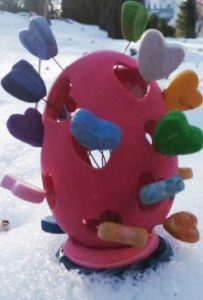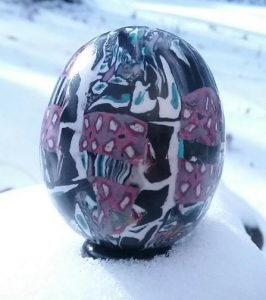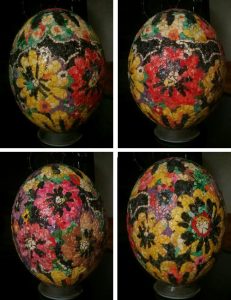This was another in a series of holey eggs (notice i did not say holy). I like the dimensionality of the eggs that have little tunnels for light to show through to the front and the rigid egg structure forms a great base for keeping the clay stable while it cures. THe logistics of getting the flowers to stay put took a little planning.
I covered an emptied with white Fimo, then before i cured it i marked out with a round cutter what areas I was going to excavate. Before curing also, i removed the uncured clay from those rounded areas but kept the eggshell intact until after it was cured and fairly rigid. ( i use small eggs generally, as adding two layers of polymer clay sheeting can ultimately create really big eggs… ha ha.
I created a spiral cane that incorporated rose petal leaves as a memorial (dark red specks seen in the red and pink and white and yellow clay are rose petal pieces)(these were from a customer’s funeral bouquet), using various shades of red and yellow and white, which i sliced thinky and applied to the egg (keeping the holes in the second layer of clay visible…and cutting edges of this layer out from the hole areas.
After curing i punched out the egg shell carefully from the holes, and sanded the outside of the egg, as well as the holes. 
I used a wire armature covered first with a thin coil of green clay then worked as a smooth casing for the stems of the flowers, and secured the flower to the end of each wire with a green polymer clay flower center and then cured all the flowers with their stems separately. After that cure I trimmed off the polymer clay up to just 1/4 inch above the length I wanted to have the stem be…. exposing just a little wire on each flower, just enough to push into uncured clay to keep them upright.
Then i pushed and molded some green polymer clay into the bottom center of the egg, shoving it through several of the holes and packing it down using the end of a pencil.
I dipped the wire (that is, the bottom end of each of the the green stems with pink flowers) in a little liquid sculpy, hoping that this would help the stems bond with the central lump on the bottom inside of the egg once i pushed the wire ends of the flower stems into it. When all flowers were arranged I cured the egg for an hour at 265 (previous cures were just long enough to harden the parts, so not a good cure….but just enough to allow me to work with the flower parts).
Three little green feet act as a stand…. i think i would have preferred, in hind sight, to have a translucent ring for a stand instead. Left and center images, side view, right image is a view from the top (taken indoors)
As is typical for me, this still needs a lot of work (mostly sanding)… i am so bad at tending to those final details… btw, no varathone on this egg…. dont know what my reasoning is there.








